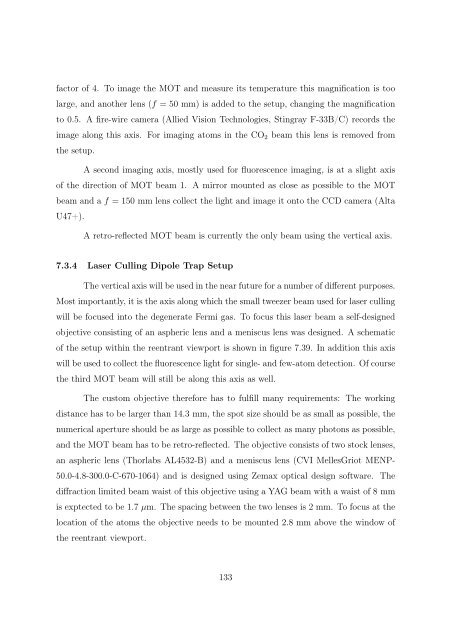Experiments to Control Atom Number and Phase-Space Density in ...
Experiments to Control Atom Number and Phase-Space Density in ...
Experiments to Control Atom Number and Phase-Space Density in ...
You also want an ePaper? Increase the reach of your titles
YUMPU automatically turns print PDFs into web optimized ePapers that Google loves.
fac<strong>to</strong>r of 4. To image the MOT <strong>and</strong> measure its temperature this magnification is <strong>to</strong>o<br />
large, <strong>and</strong> another lens (f = 50 mm) is added <strong>to</strong> the setup, chang<strong>in</strong>g the magnification<br />
<strong>to</strong> 0.5. A fire-wire camera (Allied Vision Technologies, St<strong>in</strong>gray F-33B/C) records the<br />
image along this axis. For imag<strong>in</strong>g a<strong>to</strong>ms <strong>in</strong> the CO2 beam this lens is removed from<br />
the setup.<br />
A second imag<strong>in</strong>g axis, mostly used for fluorescence imag<strong>in</strong>g, is at a slight axis<br />
of the direction of MOT beam 1. A mirror mounted as close as possible <strong>to</strong> the MOT<br />
beam <strong>and</strong> a f = 150 mm lens collect the light <strong>and</strong> image it on<strong>to</strong> the CCD camera (Alta<br />
U47+).<br />
A retro-reflected MOT beam is currently the only beam us<strong>in</strong>g the vertical axis.<br />
7.3.4 Laser Cull<strong>in</strong>g Dipole Trap Setup<br />
The vertical axis will be used <strong>in</strong> the near future for a number of different purposes.<br />
Most importantly, it is the axis along which the small tweezer beam used for laser cull<strong>in</strong>g<br />
will be focused <strong>in</strong><strong>to</strong> the degenerate Fermi gas. To focus this laser beam a self-designed<br />
objective consist<strong>in</strong>g of an aspheric lens <strong>and</strong> a meniscus lens was designed. A schematic<br />
of the setup with<strong>in</strong> the reentrant viewport is shown <strong>in</strong> figure 7.39. In addition this axis<br />
will be used <strong>to</strong> collect the fluorescence light for s<strong>in</strong>gle- <strong>and</strong> few-a<strong>to</strong>m detection. Of course<br />
the third MOT beam will still be along this axis as well.<br />
The cus<strong>to</strong>m objective therefore has <strong>to</strong> fulfill many requirements: The work<strong>in</strong>g<br />
distance has <strong>to</strong> be larger than 14.3 mm, the spot size should be as small as possible, the<br />
numerical aperture should be as large as possible <strong>to</strong> collect as many pho<strong>to</strong>ns as possible,<br />
<strong>and</strong> the MOT beam has <strong>to</strong> be retro-reflected. The objective consists of two s<strong>to</strong>ck lenses,<br />
an aspheric lens (Thorlabs AL4532-B) <strong>and</strong> a meniscus lens (CVI MellesGriot MENP-<br />
50.0-4.8-300.0-C-670-1064) <strong>and</strong> is designed us<strong>in</strong>g Zemax optical design software. The<br />
diffraction limited beam waist of this objective us<strong>in</strong>g a YAG beam with a waist of 8 mm<br />
is exptected <strong>to</strong> be 1.7 µm. The spac<strong>in</strong>g between the two lenses is 2 mm. To focus at the<br />
location of the a<strong>to</strong>ms the objective needs <strong>to</strong> be mounted 2.8 mm above the w<strong>in</strong>dow of<br />
the reentrant viewport.<br />
133

















